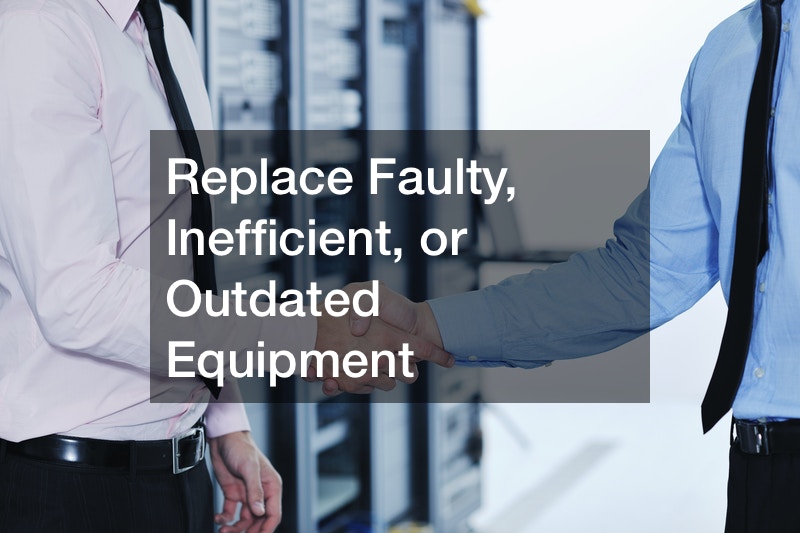Creating an effective server room is often challenging. You will probably agree if your server room is more of a squeezed IT closet than the well-round server room you envisioned. Your poorly laid-out server room could cause your system’s decrease efficiency. If you want to increase your ROI, it is about time that you designed a more effective server room.
What Are the Benefits of a Well-Designed Server Room?
There are plenty of reasons why you need to redesign your server room. The most obvious reasons are to reduce costly downtime, hardware failures and computer repair costs, and other out-of-control expenses linked to poor server room design and organization.
Redesigning your server room will improve your IT system’s cooling and power efficiency. It will also reduce carbon emissions and increase the reliability and performance of the servers. Remodeling your server room will also make repairing power equipment easier and accommodate new technologies you would like to invest in to propel your business forward.

What Are the features of the Best Server Room Design Layout?
The best layout for a server room considers ventilation, room temperature control, and network connectivity and power. A good design will also factor in seismic waves, fire disruption, and room and rack security.
There is a lot that goes into designing a server room. You need to contact a reliable electrical company to handle your server’s design and electrical wiring. Let’s look at how a qualified contractor will design a practical and efficient layout for your server room.
Ideal Location
A server room should never be located on top floors, the basement, or exterior walls. These locations are susceptible to extreme temperatures, water leaks, and high moisture levels. It is also not advisable to locate the server room deep within a building because chances are that the compressor will fail.
When looking for the ideal location for your server room, the electrician will calculate the slope of the Freon line. Suppose a server is located in the extreme interiors of a building, and you fail to calculate the slope of the Freon line correctly. In that case, the oil dissolved in the Freon could flow towards the compressor, lubricate it and eventually destroy it.
The contractor will also check the size of your current server room. If your server room is small, the contractor will suggest relocating the servers to a bigger space or discussing the option of expanding your existing room.
The server room should adequately fit your server rack cabinets and leave plenty of room for ventilation. However, the size of the room depends on the kW load of your equipment. However, the ideal foot range is 50 to 100 watts/square. You could use the existing floor tiles to map and mark the actual dimensions of the rack cabinets.
There is also no need to build a sizeable cooling system with a small server room because it will consume many utilities while it’s under operation. The contractor can install quality home air conditioners and provide a way to drain the condensate.
Install Raised Floors
Redesigning a server room also involves remodeling your floor from slab flooring to raised flooring. Installing a raised floor could have numerous benefits for your business. Raised floors are modular in design, so you can easily rearrange them or add more perforated tiles when needed. This feature is quite helpful if you plan on scaling your data center.
The more electrical upgrades you make, the larger your cooling system will require. A raised floor will allow you to place perforated tiles under new servers to facilitate airflow. You can install an additional overhead cooling system if more cooling power is needed. Raised floors allow you to install cables underground. So the overhead cooling system will be unobstructed.
Besides enhancing your cooling system, a raised flooring also increases adaptability and flexibility when rearranging servers. Moreover, performing an electrical repair in a server room with raised flooring is easy because all the cables are well laid out on the ground, and you do not need to use a ladder.

Design a Cooling System
When designing a cooling system for your server room, the IT specialists begin by calculating the server room’s specific heat dissipation capacity. An experienced IT engineer will do the calculations in kilowatts using British Thermal Units because most vendors indicate heat generation capacity in BTUs. The outcomes will determine the type of air conditioning your server room needs.
Investing in a raised floor could increase the efficiency of your cooling system. Building a raised floor will allow the air conditioners to blow into the underground space creating a lot of pressure that causes cool air to be released into the server room.
With a raised floor, you could also use water fan coils for cooling. You can use the low raised floor to bring water to them in case an accident occurs; the water cannot damage the equipment. It’s important to note that the raised floor should not be higher than 30 cm.
Set Up the Cabling System
You could use the underfloor plenum with a raised floor for electrical wiring. The server cabinets are fed the power and data cables through the bottom entry compartments. Consider using overhead trunking if you do not have a raised floor.
Each data and power cable should be mapped and tagged when wiring to identify faults when the system fails quickly. Tagging and organized cable arrangements prevent errors when removing the system or decommissioning, especially during an emergency.
Install Uninterrupted Power and Communication Channels
A server room should have an adequate uninterrupted power supply (UPS) even during interruptions of outages. An extensive network of servers, and a limited UPS, overload the supply unit during a power outage, making servers go down. Good UPS also prevents servers from being damaged during power surges, reducing your business’s expensive electrical repair costs.
When setting up UPS in the server room, the technician will calculate the duration of the autonomous power supply your system needs in minutes. You can use natural gas, gasoline, or diesel power generator. Alternatively, depending on your location, you could use a second feed line from a substation.

Replace Faulty, Inefficient, or Outdated Equipment
It is essential to plan for electrical upgrades when you are designing a server room. One of the first areas to start the upgrade on is wiring. An old wiring system decreases energy efficiency and gives you headaches during city inspections.
Your business could also benefit from upgrading your power distribution equipment, raising power availability, increasing the cooling capacity, and lowering greenhouse gas emissions and operational costs. You will also benefit from the latest technology in safety, such as fire detection and suppression.
When designing a server room, factoring in a server system upgrade is essential. Newer server models have a high memory capacity. They also have superior power-saving modes and improved cooling parts, which reduces the amount of heat in the server room that the cooling system has to eliminate.
As you replace faulty equipment, it is essential to have a proper electronic waste recycling strategy. Poor electronic waste disposal causes widespread environmental pollution, affecting people and increasing greenhouse gas emissions.
Electronics contain many hazardous chemicals to the health of plants, animals, and humans. These chemicals, which include cadmium, lead, mercury, beryllium, and bromide, terminate the soil, air, and water, affecting the health of living things and interrupting people’s livelihood. Moreover, items with embedded batteries can spark a fire.
Install an LED lighting System
Factoring in a slight upgrade, such as installing an LED lighting system when designing your server room, is also essential. LED lightbulbs are more energy efficient compared to fluorescent and incandescent lights. They last longer, are much brighter, and use less energy. Although the installation cost may be higher, their energy efficiency saves you tons of energy costs.
Install Moisture Protection
If your server room has a high moisture level, you should install moisture protection metal cases to keep the moisture level low. However, location is not the only cause of moisture in a server room.
Chilled water cooling systems and air conditioners often cause condensation and moisture leakage in the server room.
You could also create a cheaper drainage system such as a small pit, a drainage pump with a hose connected to the nearest drainage system, or design a floor with a 3% slope. The installation of metal cases in the server room cannot be effectively done with hobbyist welding.
Although this process may appear simple, attempting to DIY can lead to severe moisture damage in the server room in case of a faulty installation. You should leave this task to experienced welding personnel specializing in server room installations because they have the right contractor tools.

Enhance the Physical Security of the Data Center
When designing a server room, it’s essential to consider the physical security of the room. Physical security of the hardware system is critical for securing data in your organization. You should have a security system that restricts access to unauthorized persons.
To enhance the security of the server room, you should install an alarm on all entry and exit points to control access into the facility. This feature lets you know who gets into the facility and alert you in case of a break-in.
The server room should not have external windows because not only do they compromise the room’s security, but they also increase the challenges of controlling the temperature in the room. If you have to use a room with a window, secure it with electronic locks and panes that cannot be easily cracked open.
Install a Fire System
Your server room should have an adequate fire alarm system that consists of alarms, suppression features, fire extinguishers, and moisture detection. A server room has several electrical devices connected to numerous wires.
These connections make server rooms vulnerable to fire outbreaks in case of faulty wiring. A naked wire could spark a fire that could cause the room to go up in flames due to the flammability of the equipment in the room and the subfloor.
Most fire outbreaks in the server room occur near the uninterruptible power supply device. It is therefore vital to create a fire-proof perimeter around the UPS to prevent fire from leaking to its surrounding. You can do this by installing a gas release system that displaces oxygen from the server room to stop the fire. You can also use fire barriers for protection against fire.
Organize
Besides labeling, mounting, and bundling your power and data cables, it is essential to factor in other aspects of organization as you design your server room. Make sure all areas of the server room are accessible. This will not only allow air to circulate freely in the room, but it will also make it easy for electricians to repair equipment when they are faulty.
You also need to invest in suitable server racks. The right system of server racks will allow you to stack all your routers and switches efficiently. They are customizable and can be mounted on the wall or left free-standing. This flexibility gives you a chance to choose what your server room needs.
Designing an optimal server room is essential for increasing your equipment’s longevity and your servers’ efficiency. If you are not an IT expert, you may not design a server room that will maximize the performance of your servers because of your limited knowledge and expertise in the field.
You can, however, hire a reliable contractor to do it for you. The contractor will design an effective cooling, air conditioning, security, and organization system that will address your server room’s requirements.
